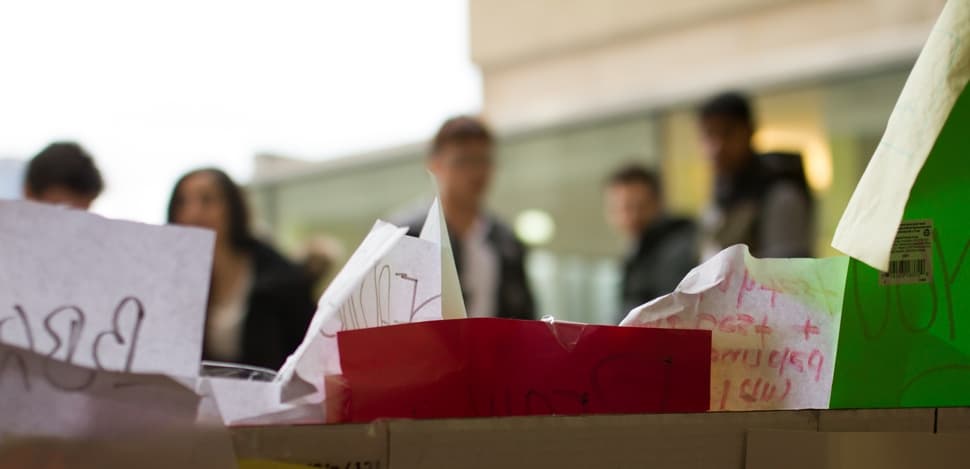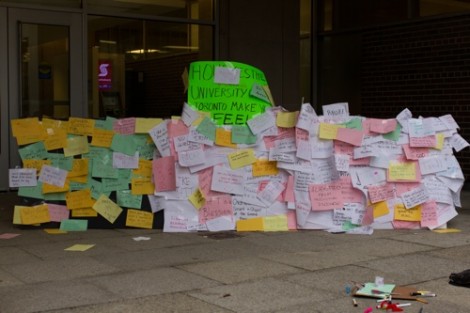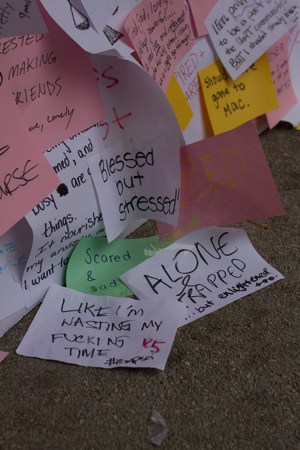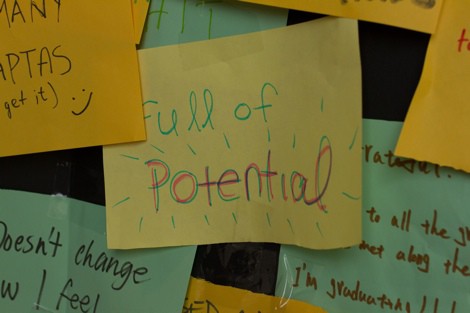In late March, outside one of the busiest locations on campus, a large white board bearing the question “How does the University of Toronto make you feel?” was quickly filled in with scribbled responses from students passing by. The adjectives “stressed,” “tired,” and “sad,” made frequent appearances, juxtaposed with more positive sentiments such as “happy,” “proud,” and “knowledgeable.”
The project is the brainchild of David Fishbayn, a psychology student. Fishbayn initially conceived the project as a way to accumulate information about collective dissatisfaction, with the long-term goal of using student responses to improve the undergraduate experience at U of T. Inspired by the work of Carl Jung, who argued that dissatisfaction can stem from an inability to integrate the unconscious mind with the conscious, Fishbayn imagined that creating a board allowing students to express their opinions about U of T would aid in this integration.

David Fishbayn, co-founder of the “How does U of T make you feel?” project. HUANG HUANG/ THE VARSITY
Fishbayn bought boards, taped them together, and set them up outside Sidney Smith Hall, where they remained for three days.
“The idea just popped into my head — wouldn’t it be interesting if everyone sort of expressed some aspect of their opinion about U of T, got it out of their head and onto a board, and then presented that board where everyone can see?” he explains.
Ariel Charney, a classmate of Fishbayn’s studying health studies, became involved when she saw the boards and was attracted to the creativity and interactive nature of the project.
“I liked the fact that it was interactive and people could validate their own emotion and put it up on a board for everyone to see,” Charney says. “It’s like this anonymous diary, and I think the anonymity of it gave so much freedom to the students to just post what thoughts they had, and that in itself is liberating.”
The project received an unprecedented response — their Facebook page has over 880 likes. The page continues to accept submissions, with some students sending in long-form personal essays.
“What was so exciting about this project was that we went from having nothing to creating this Facebook page with like 3,000 views in two weeks. It’s amazing that social media can allow us to do that,” Fishbayn says of the developments. “It took 17 days from the idea being in the notes section of my BlackBerry to being in the news section of The Globe [and Mail],” he adds.
Common themes
“I think part of the reason why this project got the sort of response it did, a much greater response than I thought would happen, was because students were interested to see that people felt the same way about the university as they did… it is sort of a nice feeling to know that the people around you are feeling the same things as you,” Fishbayn says.
Charney and Fishbayn note that many of the responses shared common themes. A number of students expressed that the size of campus made them feel disconnected. Others touched on feelings of powerlessness and a lack of control over the future.
“There’s a general pattern of feeling… I would say feeling disconnected from the school, frustrated with some of the perceived irrationalities about the institution they interact with,” Fishbayn summarizes.
“I think there’s overall frustration that you have a total lack of control over what will come,” Charney adds.
Charney and Fishbayn believe that their findings are symptomatic of a larger problem. Fishbayn comes from a psychology background and is doing research into the causes of social dissatisfaction among U of T undergraduates. He finds it helpful to consider the pattern of responses against the general trends of our generation. “I don’t know that, if I had run this experiment for my parents’ generation, that [the responses] would have applied in the same way,” Fishbayn explains.
Despite being unsure about what the project reveals about our society on a macro level, Fishbayn sees the project as being reflective of social anxieties regarding the future of our generation.
Fishbayn thinks that our goals need to change in order for our generation to be happy. “I get the sense that this cultural story of progressing towards some sort of place at the top of the dominance hierarchy is not serving individuals very well, on a very personal level. We’re seeing that people are starting to say that they need to integrate the goal of reaching the top, which is a goal very prevalent [among] U of T students, with the goal of enjoying the moment, and sometimes they conflict,” he shares.
Campus mental health resources
Charney acknowledges that, while U of T has unique issues, she has seen similar expressions of dissatisfaction at other post-secondary institutions. Charney has worked closely with the group Let’s Talk Health, as well as the Health & Wellness office, where she tries to create an environment that is better for students’ health. Let’s Talk Health strives to create an action plan to address issues of stress, mental health, anxiety, and depression on campus — problems expressed in many of the student responses to the “How does U of T make you feel?” project. Charney and Fishbayn have taken their findings to the Mental Health Action Team, a new mental health initiative co-founded by Kaleem Hawa, chair of the Trinity College Meeting, and Yolen Bollo-Kamara, University of Toronto Students’ Union (UTSU) president, which is forwarding information to the larger committee established by the provost’s office.
The university has attempted to initiate dialogue surrounding mental health by hosting focus groups with mental health groups across campus. This is in addition to the creation of the mental health committee chaired by the vice-provost. However, Charney and Fishbayn hope that their creative approach to the subject will connect with students in a way that changes to university policy cannot. Charney explains, “Stuff that happens on a policy level doesn’t always engage or mobilize people, or get them excited about being a part of something.”
Charney points out that services and resources offered by the university to help create a positive student experience can be very difficult to navigate. In her experience with Health & Wellness, Charney observed that a student in a crisis didn’t always know where to go. She saw people turning to Counselling & Psychological Services (CAPS) for academic advice, when they could be going to their dean or registrar.
One of Fishbayn’s goals is to establish an environment where students identify each other as members of the same group, in an attempt to overcome feelings of isolation on campus. Charney and Fishbayn cited lack of school spirit, fragmented divisions, and a commuter-oriented campus as contributing factors to the feeling of isolation that some students expressed. While colleges and student societies help build community, the problem, according to Fishbayn, is that the majority of students’ time is spent not with their colleges or societies, but with people in their classes, where social interactions often lack continuity and depth.
Next steps
The challenge for Fishbayn and Charney is to develop an understanding of where structural and individual changes need to be made, and they hope that this project will give them some insights. They are still accepting ideas and suggestions as to where they can take the project next. Some suggestions have included formally comparing the data to data from other Canadian post-secondary institutions, or presenting the responses in a creative way, such as a word map. They have set up an open group on Facebook, where interested students can pitch ideas and help organize the next step.
In mid-May, the latest phase of the project began with a new question. This time the query posed to students outside Sidney Smith Hall and on the group’s Facebook page asked, “What is one thing you want improved about U of T?” The intention was to help students identify the sources of their dissatisfaction and encourage them to come up with solutions. So far, the new question has amassed 110 student responses, many of them highlighting high tuition, student government, and course structures as areas for improvement.
When asked how the University of Toronto makes him feel, Fishbayn insisted that the university doesn’t determine how he feels; he does. Charney disagreed: “For me, the university has definitely impacted how I feel. There’s a general lack of connection and I don’t feel inspired anymore. I don’t think I ever did feel inspired here,” she says.
Charney and Fishbayn’s project will continue throughout the summer and into the school year, as they strive to unite U of T students as a community in a collective dialogue towards improving the university environment. Uniting a community as large and fragmented as U of T is difficult, but Charney and Fishbayn hope that answers lie in student voices. Charney shares, “It’s easy to ask students about how they feel, but the challenge is how to understand what needs to be done.”
Correction: May 30, 2014: A previous version of this article incorrectly described the Mental Health Action Team as a new mental health committee organized by the UTSU.





